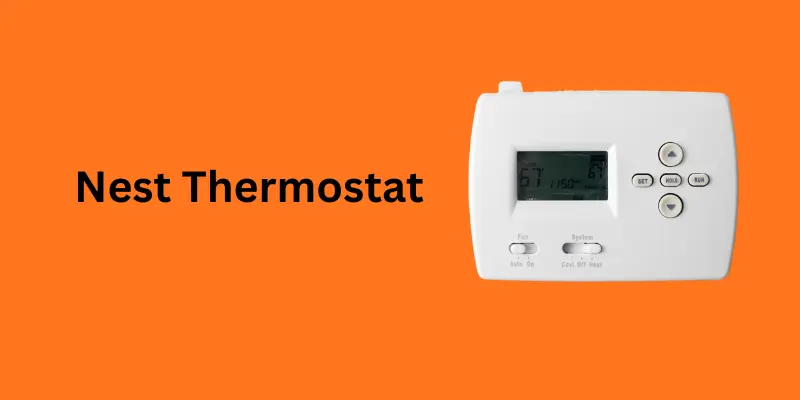Nest Thermostat Guide 2025 | Google Nest Learning Thermostat, Setup & Instructions
Updated: 26-Sep-2025
17
The Nest Thermostat has become one of the most popular smart home devices in America, redefining how people manage comfort and energy use at home. Originally created by Nest Labs and later acquired by Google, this intelligent thermostat combines sleek design with smart learning technology. For homeowners across the U.S., the Google Nest Thermostat isn’t just a gadget—it’s a tool to save energy, reduce bills, and simplify home climate control.

Whether you search for the Nest Thermostat manual, want to understand the Google Nest Thermostat installation process, or are curious about the Nest Learning Thermostat 4th generation, this guide covers everything you need to know.
What is a Nest Thermostat?
A Nest Thermostat is a smart thermostat that connects to Wi-Fi and allows you to control your home’s heating and cooling systems from anywhere using your smartphone, the Google Home app, or your voice via Google Assistant or Alexa.
Unlike traditional thermostats, Nest devices are designed to learn your schedule, adjust automatically, and optimize energy use. Over time, the thermostat understands your habits, such as when you wake up, leave for work, or go to sleep, and adjusts your home temperature accordingly.
History and Evolution of Nest Thermostats
- 2011: The first Nest Learning Thermostat was introduced by Nest Labs.
- 2014: Google acquired Nest Labs.
- 2017: Nest introduced more affordable models alongside the 3rd generation Nest Learning Thermostat.
- 2020: The new Nest Thermostat launched, focusing on affordability while maintaining smart features.
- 2023–2024: Rumors and demand for the Nest Thermostat 4th generation or Google Nest Thermostat 4th generation grew, with Americans expecting better AI integration and more efficient HVAC compatibility.
Today, Nest thermostats are available in multiple versions, including the Nest Learning Thermostat and the standard Google Nest Thermostat.
Models of Nest Thermostat (2025 Lineup)
Google currently markets multiple Nest thermostat models. Here’s a comparison table for American buyers:
| Model | Price (USD) | Key Features | Compatibility | Best For |
|---|---|---|---|---|
| Nest Thermostat (2020 model) | $129–149 | Energy-saving, app control, simple design | Works with most 24V HVAC | Budget-friendly buyers |
| Nest Learning Thermostat (3rd Gen) | $249–269 | Auto-schedule, Farsight display, energy reports | Compatible with most systems | Homeowners wanting premium smart features |
| Nest Learning Thermostat (4th Gen) | $279–299 | Upgraded sensors, improved AI, tighter Google Home integration | Advanced multi-stage systems | Energy-conscious households, smart homes |
| Nest Thermostat E (phased out but still sold in parts of the U.S.) | $169–199 | Frosted display, simple app use | Limited compatibility | Renters and smaller homes |
Note: Google has announced end-of-support for some older Nest thermostats (1st & 2nd gen), which means limited app functionality after official cutoff dates. Buyers in 2025 should consider 3rd gen or newer models.
Why Americans Choose the Nest Thermostat
- Energy Savings – Studies show that Nest Thermostats can save 10–15% on heating and cooling bills.
- Convenience – Control the Google thermostat from anywhere using your phone.
- Smart Features – Learns your habits and adjusts automatically.
- Compatibility – Works with most HVAC systems in American homes.
- Integration – Seamlessly connects with the Google Home ecosystem.
Types of Nest Thermostats
1. Nest Learning Thermostat
The flagship model, currently in its 3rd generation, is known for:
- Auto-scheduling based on your behavior.
- Energy history tracking.
- Stylish circular design with a digital display.
- Wide HVAC compatibility.
The much-anticipated Nest Learning Thermostat 4th generation is expected to improve even further with AI-powered features.
2. Google Nest Thermostat (Standard Version)
A more affordable option, released in 2020:
- Controlled primarily through the Google Home app.
- Features a mirrored display instead of a rotating ring.
- Designed for budget-conscious Americans who still want smart control.
Nest Thermostat Manual and Instructions
Every Nest thermostat manual provides step-by-step setup and troubleshooting guidance. But here are some key Nest thermostat instructions Americans often search for:
- How to use Nest Thermostat: Adjust directly on the device or through the Google Home app.
- Schedule settings: Customize heating/cooling schedules or let it learn automatically.
- Eco Mode: Saves energy when nobody’s home.
- System Compatibility: Works with most U.S. HVAC systems, including gas, electric, and heat pump units.
If you misplace your Nest thermostat manual, you can always access a digital copy online.
How the Nest Thermostat Saves Energy
One of the biggest selling points for Americans is energy savings. With rising electricity and gas costs, Nest provides measurable reductions in utility bills.
- Learning Schedule: After a week of manual adjustments, Nest begins setting its own automatic schedule.
- Eco Mode: Detects when nobody’s home (via motion sensors & phone location) and adjusts temperatures.
- HVAC Monitoring: Alerts if your heating/cooling system behaves abnormally, helping prevent costly repairs.
- Seasonal Savings: Makes gradual changes during peak heating/cooling months to cut energy waste.
- Energy Reports: The app provides monthly reports showing estimated savings vs. average usage.
Google Nest Thermostat Installation Guide
Many Americans want to know how easy Google Nest installation really is. The good news: most homeowners can do it themselves.
Steps for Google Nest Thermostat Installation:
- Turn Off Power – Shut off your HVAC system.
- Remove Old Thermostat – Take note of the wiring labels.
- Connect Wires – Use the Nest base plate to connect wires according to the Nest thermostat instructions.
- Mount the Thermostat – Secure it to the wall.
- Turn Power Back On – The device will power up and guide you through setup.
- Connect to Wi-Fi – Link with the Google Home app for smart control.
If unsure, you can hire a professional installer, but most Americans find Google Nest thermostat installation simple with online guides.
How to Use Nest Thermostat
Many first-time buyers in the U.S. ask, “How to use Nest Thermostat?” The process is simple:
- Adjusting temperature: Rotate (Learning model) or tap/swipe (standard model).
- Mobile control: Use the Google Home app to change settings remotely.
- Voice commands: Say, “Hey Google, set the thermostat to 72 degrees.”
- Energy history: Check the app for daily/weekly reports.
Nest Thermostat 4th Generation Expectations
Though not officially released yet, the Nest Thermostat 4th generation or Nest Learning Thermostat 4th generation is one of the most searched topics by Americans. Consumers expect:
- Better AI learning features.
- Longer battery life.
- Enhanced HVAC compatibility.
- Even more precise scheduling.
- Improved energy reporting.
The Google Nest Thermostat 4th generation could become the most advanced smart thermostat in America.
Google Home Thermostat vs. Nest Thermostat
Sometimes Americans search for a Google Home thermostat, but technically, there isn’t a separate device. The term usually refers to the Nest Thermostat because it integrates with the Google Home app.
- Nest Thermostat = The device itself.
- Google Home thermostat = The Nest Thermostat as controlled via the Google Home ecosystem.
So, they are essentially the same product, just different phrasing.
Nest Thermostat Features Americans Love
- Auto-Schedule – Learns and adapts.
- Remote Control – Adjust anywhere in the U.S.
- Energy Reports – Monthly savings updates.
- HVAC Monitoring – Alerts you when something’s wrong with your system.
- Family Accounts – Multiple users can control it.
- Eco Mode – Energy-saving option when you’re away.
- Integration – Works with Google Assistant and Alexa.
Pros and Cons of Nest Thermostats
| Pros | Cons |
|---|---|
| Saves energy & lowers bills | Higher upfront cost |
| Easy to install | Some older HVAC systems may need adapters |
| Stylish design | Occasional Wi-Fi issues |
| Remote control via phone | Advanced features limited on cheaper model |
| Works with smart assistants | Learning curve for first-time users |
Troubleshooting & Common Issues
Even the best smart devices encounter occasional hiccups. Here are common Nest thermostat issues in U.S. homes and solutions:
- Nest thermostat not connecting to Wi-Fi → Restart router, check 2.4GHz/5GHz compatibility, reset thermostat.
- Battery low warning → Charge via USB or check C-wire connection.
- Heating/cooling not working correctly → Verify wiring matches system type (heat pump, furnace, etc.).
- Frozen display or unresponsive unit → Hold down thermostat ring for 10 seconds to restart.
- Nest thermostat not turning on AC → Check power supply, HVAC breaker, or schedule settings.
Nest Thermostat vs Competitors
Many Americans also compare Nest with Ecobee and Honeywell smart thermostats.
| Feature | Nest Learning Thermostat | Ecobee Smart Thermostat | Honeywell Home T9 |
|---|---|---|---|
| Price | $249 | $249 | $199 |
| Smart Learning | Yes | No (manual schedules) | Limited |
| Voice Assistant | Google, Alexa | Alexa built-in, Google | Alexa, Google |
| Remote Sensors | Optional | Included | Included |
| App Control | ✅ | ✅ | ✅ |
| Energy Reports | ✅ | ✅ | ✅ |
Verdict: Nest excels in auto-learning and ease of use, Ecobee wins in sensor coverage, while Honeywell offers budget flexibility.
Pricing, Warranty & Support
- Nest Thermostat (2020): $129–149
- Nest Learning Thermostat (3rd Gen): $249–269
- Nest Learning Thermostat (4th Gen): $279–299
- Nest Sensors: $39 each or 3-pack for $99
Warranty:
- Nest Thermostat (2020): 1-year limited warranty
- Nest Learning Thermostat: 2-year warranty
Support:
- Google Home app and Nest Help Center
- Live chat & phone support (U.S. only)
- Note: Older models will lose app support after cutoff dates in 2025, per Google’s official announcement.
FAQs About Nest Thermostats
1. Is the Nest Thermostat worth it?
Yes. Most U.S. homeowners save enough on utility bills within 1–2 years to cover the cost.
2. How much does a Nest Thermostat cost?
Typically between $99–$249, depending on the model and generation.
3. Does Nest Thermostat work with Alexa?
Yes, in addition to Google Assistant.
4. Can I install a Nest Thermostat myself?
Yes. The Google Nest thermostat installation process is DIY-friendly, but professional help is available.
5. Does it work without Wi-Fi?
Yes, but you lose remote control and advanced smart features.
6. How do I reset a Nest Thermostat?
Go to Settings → Reset → Restart or Factory Reset.
7. What’s the difference between Nest Learning Thermostat and Nest Thermostat?
The Learning model has auto-schedule and a rotating dial; the standard model relies more on manual app scheduling.
8. Is there a Nest Thermostat 4th Generation?
Not officially yet, but rumors suggest an update is coming.
9. Does it work with heat pumps?
Yes, Nest supports most American HVAC systems, including heat pumps.
10. Is the new Nest Thermostat better than the Learning model?
The new Nest Thermostat (budget model) is more affordable but has fewer smart features than the Nest Learning Thermostat.
Summary
The Nest Thermostat has become a household name across America, transforming the way people heat and cool their homes. Whether you’re considering the Google Nest Thermostat, the Nest Learning Thermostat, or waiting for the Nest Thermostat 4th generation, all models are designed to save money, increase comfort, and provide smarter control.
From Google Nest thermostat installation to using the Nest thermostat manual for troubleshooting, the device is built for ease of use and energy efficiency. For U.S. homeowners, it’s not just a thermostat—it’s an investment in smarter living.

Conclusion
In today’s fast-paced world, where Americans want comfort, energy savings, and smart control, the Nest Thermostat stands out as one of the best choices. It combines style, intelligence, and practicality, making it more than just a thermostat—it’s part of a smart home ecosystem.
So, whether you call it a Nest Thermostat, Google Nest Thermostat, Google Home Thermostat, or the new Nest Thermostat, one thing is clear: this device continues to set the standard for smart climate control in American homes.
Please Write Your Comments